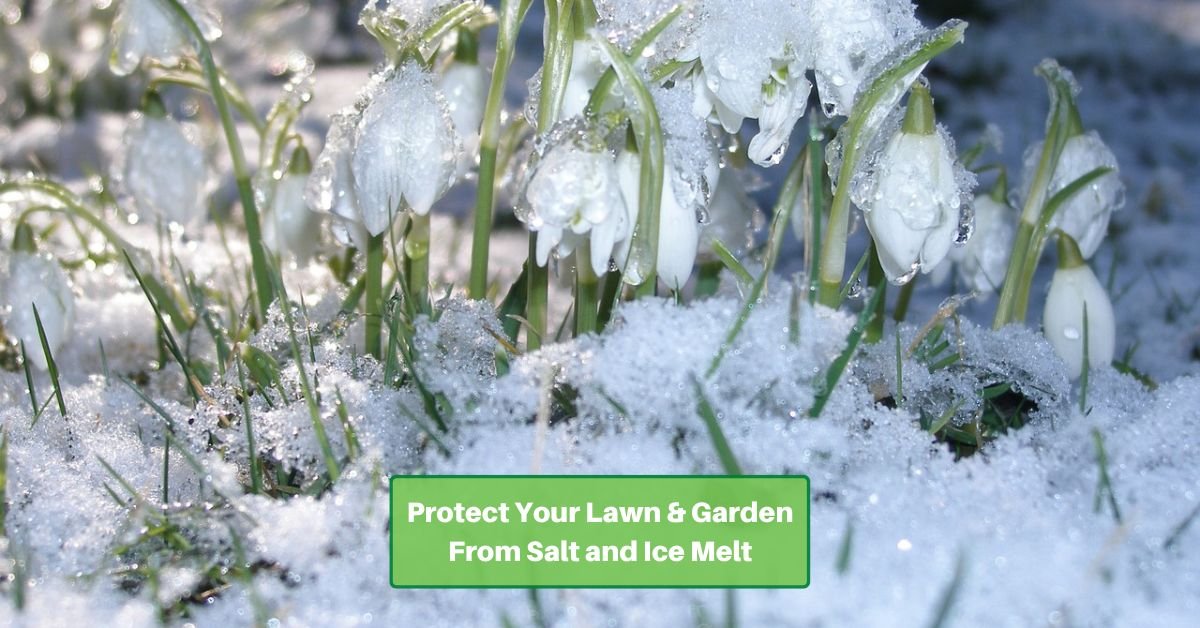Winter, at least in many parts of the world, brings snow and ice – and the need to remove these slippery materials from sidewalks, patios, and porches. The quick solution is to reach for ice melt and salt to ensure safety on walkways and driveways.
These products effectively prevent slips and falls but can pose a significant threat to our lawns and garden plants. The challenge for gardeners and homeowners is to balance the need for safety with the desire to protect the vibrant life in their gardens. Here, we’ll delve into the impact of ice melt and salt on plant life and outline strategies for safeguarding our green spaces against these winter necessities.
Understanding Salt Damage
Ice melt and salt products work by lowering the freezing point of water, effectively melting ice and snow. However, when these products are used near garden areas, they can lead to salt accumulation in the soil, causing dehydration in plants by drawing water away from their roots.
They also lead to nutrient imbalances and soil structure disruption. Over time, salt damage can manifest as browned foliage, stunted growth, or even the death of plants, severely affecting the soil’s health and ability to support plant life.
Types of Ice Melt Products
The market offers a variety of ice melt products, each with its own set of advantages and disadvantages for plant health:
- Rock Salt (Sodium Chloride): The most common and inexpensive option, rock salt is also the most damaging to plants and soil due to its high sodium content.
- Calcium Chloride: While more expensive, calcium chloride is effective at lower temperatures and less harmful to plants. However, overuse can still lead to soil toxicity.
- Magnesium Chloride: Magnesium chloride is known for being less damaging to plants and concrete surfaces. It’s safer than other options, but like all deicing agents, it requires careful application to minimize environmental impact.
Understanding the specific effects of these deicing agents is crucial for making informed decisions that balance safety with environmental stewardship.
Preventive Measures for Protecting Plants
The first line of defense against salt damage is prevention. Here are several strategies gardeners can employ to protect their green spaces:
- Minimize Use Near Gardens: Whenever possible, reduce the use of ice melt and salt near garden areas. Opt for physical removal of snow and ice using shovels or snow blowers to prevent the need for chemical deicers.
- Use Barrier Methods: Protecting plants from salt spray and runoff can be as simple as erecting physical barriers. Burlap screens, plastic sheeting, or even snow fences can shield plants from direct exposure to salt.
- Choose Resistant Plants: Some plant varieties exhibit greater resistance to salt damage. Incorporating these plants into garden borders closest to walkways or driveways where salt application is likely can reduce the overall impact on your garden. Coleus, daylilies, English ivy, and creeping juniper make good border plants that hold up well against salt.
Implementing these preventive measures can significantly reduce the risk of salt damage to lawns and gardens. Adopting a proactive approach to managing ice melt and salt ensures that our gardens remain safe havens for plants, wildlife, and the many beneficial insects that call them home.
Mitigating Salt Damage
Once the winter has passed and the snow has melted away, it’s time to assess and address the impact of salt on your garden and lawn. Here are actionable steps to help rejuvenate and restore your green spaces:
- Flushing the Soil: Early spring is the ideal time to start flushing out the accumulated salts from your soil. Generously watering affected areas can help dilute salt concentrations, but you need to ensure proper drainage to avoid waterlogging. This simple yet effective method can kickstart the recovery process for your plants and soil.
- Soil Amendments: Restoring soil health is paramount after salt exposure. Incorporating organic matter like compost or aged manure can enhance soil structure, improve water retention, and help rebalance nutrient levels. In areas severely affected by salt, consider adding gypsum (calcium sulfate) to help replace sodium ions with calcium. This process can further aid in soil recovery.
- Pruning Damaged Vegetation: Inspect your plants for salt damage—browned foliage, stunted growth, or branch dieback are common symptoms. Pruning damaged parts can stimulate new growth and help plants direct their energy towards recovery. Be patient, as some plants may take longer to show signs of rejuvenation.
Alternative Deicing Solutions
Alternatives to deicing solutions are also good to consider because of the potential harmful effects these products can have on plants, pets, and surfaces. Here are a few eco-friendly options to consider:
- Sand or Non-clumping Kitty Litter: Kitty litter and ash don’t melt ice but can provide traction on slippery surfaces, reducing the risk of falls. They can be easily swept away once the ice has melted, leaving no harmful residues in your garden.
- Beet Juice: An innovative deicing solution, beet juice mixed with traditional salt brines can reduce the salt needed for effective deicing. The organic compounds in beet juice help lower the freezing point of water, and its minimal environmental impact makes it a favorable choice for eco-conscious gardeners.
- Calcium Magnesium Acetate (CMA): Though more expensive, CMA is a biodegradable deicer that is less corrosive and harmful to plants and soil than traditional salt. It’s an effective option for areas close to vegetation and water bodies.
Lawn and Garden Recovery Post-Winter
The true extent of winter’s toll on your garden may only become apparent as the season changes. Early spring is a critical time for:
- Assessing Winter Damage: Walk through your garden, noting areas particularly affected by salt or ice melt. Look for signs of soil compaction, nutrient deficiencies, or pH imbalances that may need addressing.
- Spring Lawn Care: Aerate your lawn to alleviate compaction and promote oxygen, water, and nutrient flow to the roots. Overseeding can help fill in bare patches, and a balanced fertilizer can support healthy growth as your lawn recovers from winter stress.
- Garden Maintenance: Test your soil to understand its needs better and make informed decisions about amendments and fertilizers. Planting salt-tolerant species in vulnerable areas can offer a more resilient landscape.
Protecting our lawns and garden plants from the detrimental effects of ice melt and salt is a task that spans from preventive measures to post-winter recovery efforts. By embracing eco-friendly deicing alternatives and implementing strategies to mitigate damage, you can ensure your green spaces survive and thrive, even in the face of winter’s challenges.









